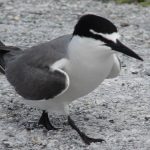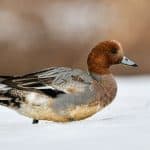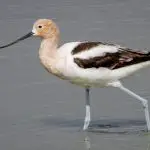Common Name: Black-bellied Plover
Scientific Name: Pluvialis squatarola| Size | Diet | Range in Hawaii | Status in Hawaii |
|---|---|---|---|
| 11 in. | marine worms, crustaceans, and mollusks | Common on all islands | Least Concern |
The Black-bellied Plover (Pluvialis squatarola) is a striking shorebird that is known for its distinctive black and white plumage and mournful-sounding call. With its agile and swift aerial movements, this bird is a true master of the skies. While it is typically found in the Arctic regions of North America and Eurasia, it has also been known to make appearances in other parts of the world, including Hawaii. In fact, the Black-bellied Plover is a common winter visitor to Hawaii, where it can be spotted on beaches and in coastal areas. In this article, we’ll take a closer look at this fascinating bird species, including its physical characteristics, behavior, and habitat preferences, as well as its presence in Hawaii.
Black-bellied plover
Appearance
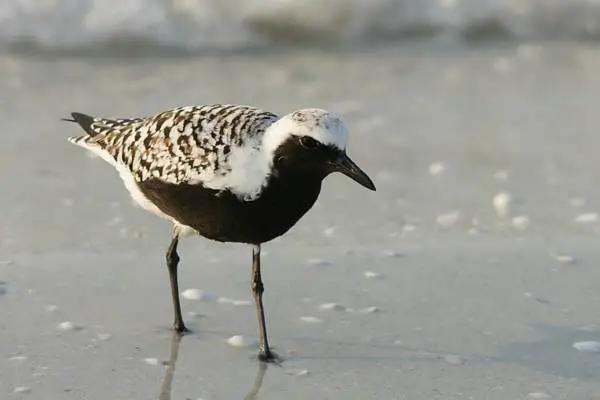
This remarkable shorebird stands out with its exquisite features and a size of approximately 11 inches in length. With a mottled brown back that blends seamlessly with its coastal habitats, the Black-bellied Plover’s most distinctive characteristic is its jet-black belly, creating a striking contrast. During breeding season, observe the mesmerizing transformation as its plumage adorns an intricate pattern, showcasing the marvels of nature’s artistry.
Diet
As a shorebird, it primarily feasts on a delectable assortment of invertebrates found along coastal regions. Picture it skillfully probing the sand and mudflats with its long, slender beak, searching for delectable morsels like marine worms, crustaceans, and mollusks. Black-bellied Plover may also indulge in a plant-based menu, including berries and seeds.
Nesting
These resourceful birds opt for nest sites in the remote and pristine Arctic tundra, where they create simple yet well-camouflaged depressions on the ground. In an impressive display of adaptability, they strategically choose nesting locations far away from potential predators and human disturbances.
Observing the Black-bellied Plover during the nesting season unveils their remarkable parental instincts. Males play an active role in the entire nesting process, from selecting the nest site to defending the territory. Females lay a clutch of four eggs, which are expertly camouflaged to blend with the surrounding environment.
Once the eggs hatch, the fluffy chicks embark on an incredible journey. Unlike many other bird species, the precocial Black-bellied Plover chicks are able to leave the nest shortly after hatching. With their parents’ guidance, they scurry through the tundra, foraging for food and evading potential threats.
Behavior
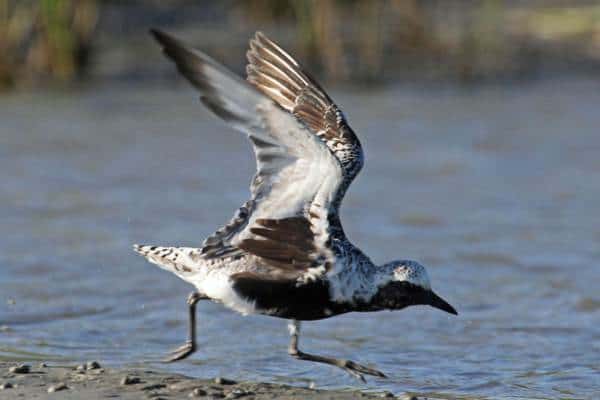
These charismatic shorebirds display remarkable agility and coordination as they navigate their coastal habitats. One notable behavior is their adeptness at foraging. Watch in awe as they skillfully probe the sand and mudflats, swiftly extracting tasty invertebrates with their long, slender beaks.
During migration, the Black-bellied Plover engages in awe-inspiring long-distance journeys, sometimes spanning thousands of miles. Witness the spectacle of flocks of these birds soaring through the sky, their synchronized flight patterns a testament to their remarkable navigational abilities.
Social interactions among Black-bellied Plovers are equally captivating. They often gather in small groups, engaging in intriguing courtship displays. Males flaunt their breeding plumage, showcasing a splendid combination of colors, while engaging in acrobatic flights to attract females.
Remarkably, the Black-bellied Plover displays an adaptive behavior known as “freeze-drying.” When threatened, they freeze in place, their feather patterns blending seamlessly with the surrounding environment, effectively camouflaging themselves from potential predators.
Habitat
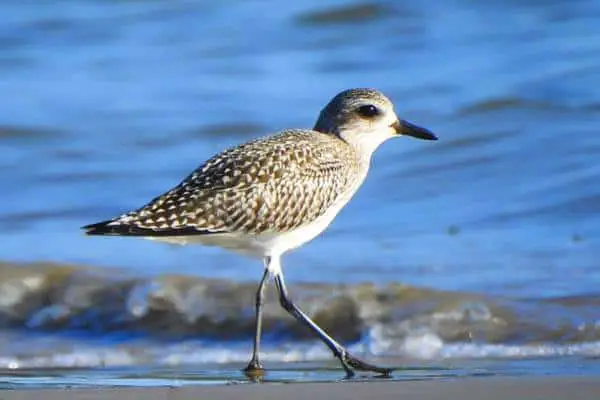
During the breeding season, these remarkable birds seek out remote Arctic tundra regions, where they find solace amidst the vast and pristine landscapes. During migration, these birds embark on incredible journeys, traversing vast distances to reach their wintering grounds. Along the way, they make use of a variety of habitats, including mudflats, saltmarshes, and sandy beaches. In their wintering grounds, the Black-bellied Plover can be found in a diverse array of coastal habitats, including estuaries, lagoons, and intertidal mudflats.
Range
The Black-bellied Plover can be found on various islands of Hawaii during the winter months, including but not limited to Maui, Oahu, Kauai, and Hawaii (the Big Island). These stunning birds bring their Arctic allure to the coastal areas, beaches, and mudflats of these specific islands, enriching the avian diversity of each location.
Conservation Status
The Conservation Status of the Black-bellied Plover warrants attention and action. Classified as a species of “Least Concern” by the International Union for Conservation of Nature (IUCN), these beautiful shorebirds still face threats that require vigilance and conservation efforts.
Interesting Facts
1. Seasonal costume change
The Black-bellied Plover undergoes a remarkable transformation during breeding season. Their plumage changes to a striking black-and-white pattern with a prominent black belly, earning them their distinctive name. After breeding, they molt and transition back to their non-breeding plumage.
2. Impressive wingbeat
The Black-bellied Plover has a distinctive flight style. When flying, they showcase rapid and shallow wingbeats, often accompanied by quick glides. This flight pattern allows them to cover long distances efficiently during their migrations.
3. Vocal communication
Black-bellied Plovers use a variety of vocalizations to communicate. Their calls include a melodious, flute-like whistle and a sharp, alarm-like call when they feel threatened or disturbed.
4. Wing signal display
During courtship and territorial displays, male Black-bellied Plovers may perform a unique behavior known as the “wing signal.” This involves partially spreading their wings to reveal the contrasting black and white patterns, enhancing their visual allure.
5. Name confusion
Despite its name, the Black-bellied Plover is not the only plover species with a black belly. In fact, several other plover species, such as the American Golden-Plover, also display black bellies during the breeding season.
Frequently Asked Questions
1. Can Black-bellied Plovers swim?
While Black-bellied Plovers are primarily terrestrial birds, they are capable of swimming if necessary. They may take short swims in shallow water to escape predators or reach suitable foraging areas.
2. How fast can Black-bellied Plovers fly?
Black-bellied Plovers can fly at speeds of up to 40-50 miles per hour (65-80 kilometers per hour) during migration and when evading predators.
3. Can Black-bellied Plovers fly long distances without resting?
Black-bellied Plovers are capable of flying long distances without resting. They have the endurance to undertake non-stop flights of several thousand kilometers during their migration.
4. What is the typical lifespan of a Black-bellied Plover?
The average lifespan of a Black-bellied Plover is around 5-7 years, although some individuals have been known to live up to 13 years.
Do Black-bellied Plovers engage in mobbing behavior?
Yes, Black-bellied Plovers are known to engage in mobbing behavior. They may gather and vocalize loudly to harass and drive away predators, such as birds of prey or mammals, that pose a threat to their nests or young.

